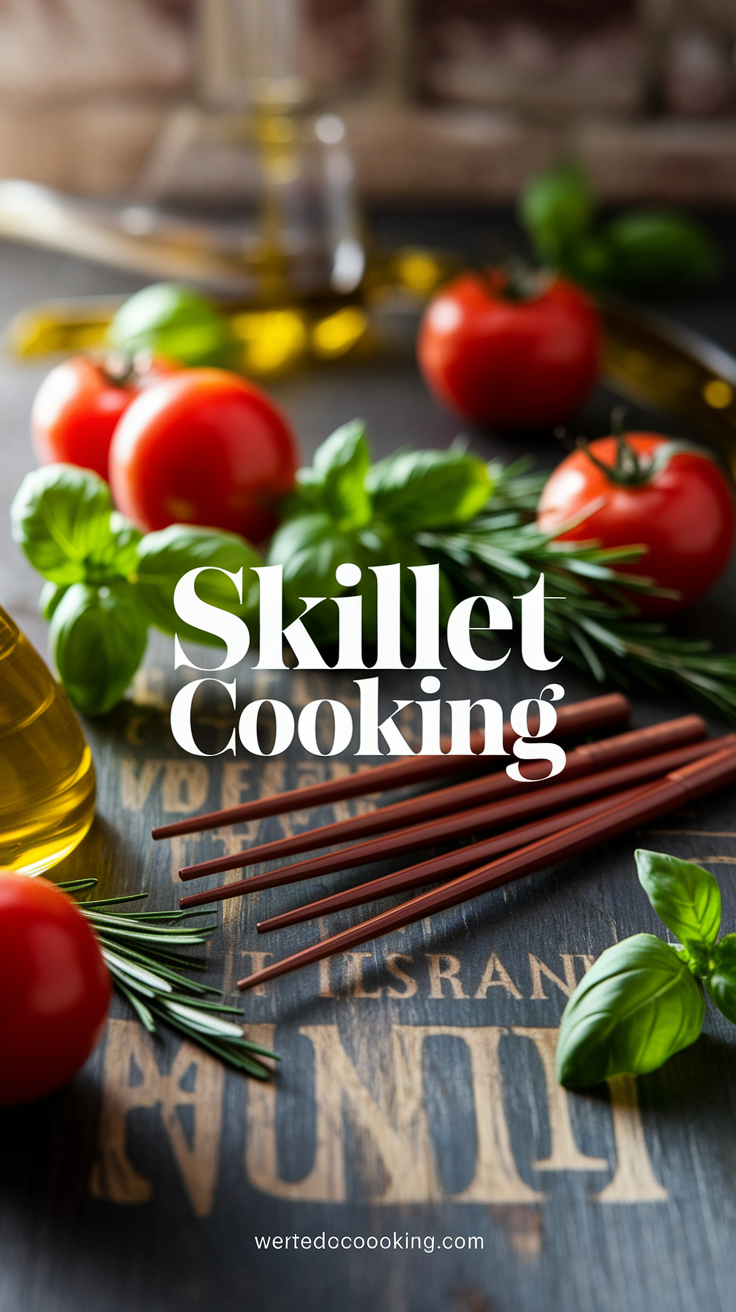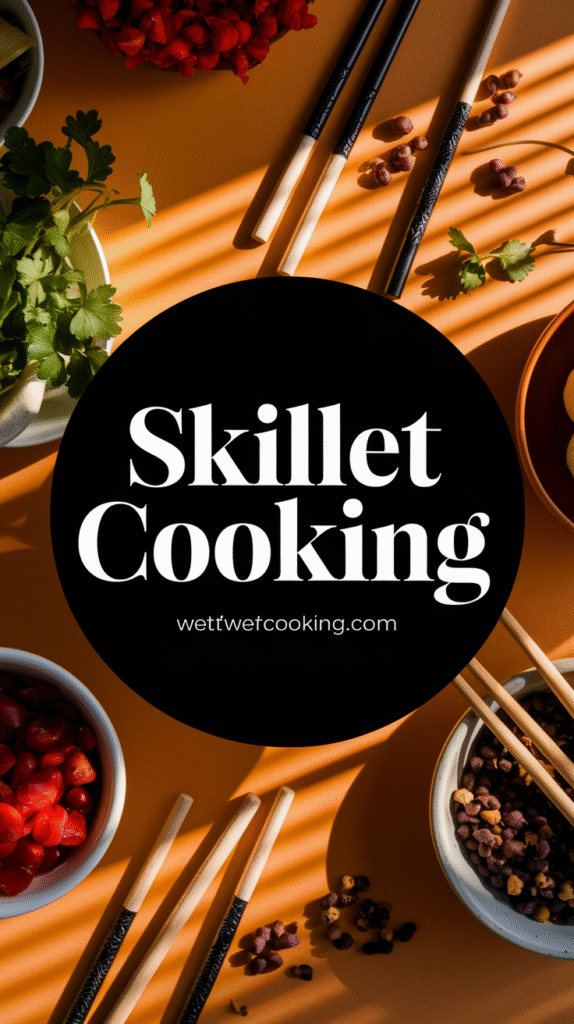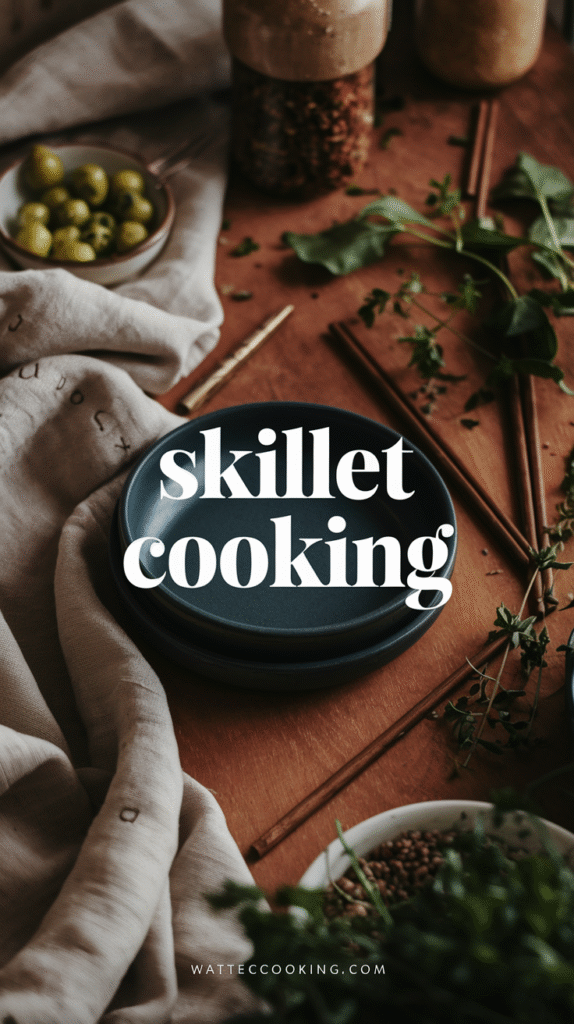Skillet cooking is an age-old method that has made its way into the hearts of home cooks and professional chefs alike. It’s versatile, fun, and brings out the natural flavors of the ingredients. Whether you prefer a non-stick, cast-iron, or stainless-steel skillet, mastering skillet cooking is a wonderful way to elevate your culinary skills. Here are some techniques and tips to help you create delicious skillet meals.
Choosing the Right Skillet
The type of skillet you choose can affect your cooking experience and the outcome of your meals. Here’s a quick look at the popular options:
- Cast Iron: Great for heat retention and adds a unique flavor to your dishes. Ideal for searing and oven roasting.
- Non-Stick: Perfect for eggs and delicate ingredients. Easy to clean but may not brown food as well.
- Stainless Steel: Excellent for browning and deglazing, requires a bit more oil to prevent sticking.
Essential Techniques for Skillet Cooking
Understanding the right techniques can make a world of difference in skillet cooking. Below are some essential techniques to perfect your dishes:
1. Preheating the Skillet
Always preheat your skillet before adding ingredients. This step helps achieve better searing and browning. To test the heat, sprinkle a few drops of water into the skillet; if they sizzle and evaporate immediately, it’s ready to go!
2. Use the Right Amount of Oil
Using oil is crucial to avoid sticking and enhance flavor. Choose oils with high smoke points, like canola or avocado oil. Depending on the dish, you may start with a generous drizzle or just a thin film to coat the bottom of the skillet.
3. Avoid Overcrowding
To achieve a good sear, avoid overcrowding the skillet. If you add too many ingredients at once, they will steam rather than brown. Cook in batches if necessary.
4. Mastering Heat Control
Controlling the heat is vital while cooking. Start on medium-high to sear and brown, then reduce the temperature as needed to cook through without burning.
5. Deglazing for Flavor
Once you’ve cooked your protein or vegetables, consider deglazing the skillet. This involves adding a splash of liquid, such as broth, wine, or vinegar, to lift the tasty browned bits stuck to the pan. This not only enhances the flavor of your dish but also makes cleanup easier!
Creative Skillet Cooking Ideas
The beauty of skillet cooking lies in its versatility. Here are some creative dish ideas to inspire your next meal:
- One-Pan Pasta: Cook pasta directly in the skillet with sauce and vegetables for a quick, flavorful dish.
- Frittatas: Mix eggs with leftover vegetables and cheese, then cook until set for a hearty breakfast or brunch.
- Stir-Fries: Perfect for using up vegetables and proteins—just toss everything in the skillet with sauce for an easy, healthy meal.
Skillet Cooking Safety Tips
While skillet cooking is enjoyable, safety should always be a priority. Here are a few tips to keep in mind:
- Use Oven Mitts: Always protect your hands when handling hot skillets, especially if they’re cast iron.
- Watch for Oil Splatter: When cooking with oil, be mindful of the heat level to prevent splattering.
- Keep Flammable Items Away: Ensure that towels or paper items are kept away from the stove while cooking.
Embracing the art of skillet cooking not only enhances your culinary repertoire but also allows for greater creativity in the kitchen. You can learn more techniques and recipes by checking out resources like Serious Eats or Food Network. Start exploring this exciting cooking method and enjoy the delicious results!
Exploring Different Types of Skillets for Various Cooking Styles
Cooking with skillets is a versatile and enjoyable way to prepare meals. With various types of skillets available, it’s essential to choose the right one for your cooking style. Below, you’ll learn about different skillets and their unique features, so you can find the perfect match for your kitchen adventures.
Cast Iron Skillets
Cast iron skillets are a staple in many kitchens due to their durability and heat retention. Here are some key points about cast iron skillets:
- Heat Distribution: They distribute heat evenly, making them perfect for frying, baking, and sautéing.
- Non-Stick Properties: With proper seasoning, they can develop a natural non-stick surface, improving over time.
- Versatile Use: They can be used on the stovetop, in the oven, or even over an open flame.
If you want to invest wisely, consider a high-quality cast iron skillet from Lodge Cast Iron, known for their craftsmanship.
Non-Stick Skillets
Non-stick skillets are an excellent choice for low-fat cooking, allowing you to prepare meals without excessive oils and fats. Here’s why they are popular:
- Easy Release: Food slides off easily, which is great for cooking delicate items like eggs and pancakes.
- Simple Cleanup: Most non-stick skillets are easy to clean and require minimal scrubbing.
- Lightweight: They are generally lighter than cast iron, which makes handling easier.
For quality non-stick options, check out GreenPan, which focuses on healthy cooking with eco-friendly materials.
Stainless Steel Skillets
Stainless steel skillets offer a sleek, modern look and exceptional cooking performance. Here are the highlights:
- Durable and Long-Lasting: They resist rust and corrosion, making them a lasting investment.
- Non-Reactive Surface: Perfect for cooking acidic foods like tomatoes without any reactions.
- Ideal for Searing: They provide excellent browning capabilities for meats and vegetables.
A well-known brand for stainless steel cookware is All-Clad, recognized for its professional and high-end cookware.
Coated Skillets
Many coated skillets feature a non-stick surface, but they may come with specific designs for unique cooking tasks. Consider these factors:
- Colored Coatings: They can brighten up your kitchen and come in various vibrant colors.
- Even Heat Distribution: Most are engineered to distribute heat evenly, benefiting your cooking.
- Versatile Handling: Often lightweight and easy to maneuver, they cater to quick meals.
For innovative coated skillet options, explore what Tefal offers, especially in their non-stick range designed for easy cooking.
Skillet Sizes and Shapes
Understanding the sizes and shapes of skillets can further enhance your cooking experience. Here’s a quick overview:
| Size | Use | Cooking Style |
|---|---|---|
| 8-Inch | Single servings | Frying eggs, small amounts of sauté |
| 10-Inch | For small families | Pancakes, grilling sandwiches |
| 12-Inch | For larger meals | Stir-frying, searing meats |
Selecting the right size depends on your cooking needs. A good guideline is to choose a skillet based on the typical portion sizes you prepare.
Exploring different types of skillets can greatly improve your cooking style and efficiency. By understanding the features and benefits of each skillet type, you can enjoy delicious meals with ease. Remember to choose a skillet that fits your preferences and enhances your culinary experience!
Health Benefits of Cooking with a Skillet
Skillet cooking is not just a way to prepare food—it offers numerous health benefits that can enhance your overall well-being. When you cook with a skillet, you’re engaging in a method that encourages healthier eating habits, preserves nutrients, and enhances flavors without excessive fats or oils. Understanding these health benefits can inspire you to incorporate more skillet meals into your routine.
One of the most significant advantages of skillet cooking is its ability to promote healthier cooking practices. Since skillets tend to conduct heat evenly, they allow for quick cooking at high temperatures. This process can help retain the nutrients in vegetables and meats, ensuring that your meals are both tasty and nutritious. Quick cooking methods, such as sautéing, can preserve the natural flavor and color of ingredients, making your meals not just nutritious but visually appealing as well.
Another key aspect of skillet cooking is the versatility it brings. From frying to sautéing and even baking in some cases, skillets can be used to prepare a wide variety of dishes. This can lead to a more diverse diet, which is essential for obtaining various vitamins and minerals. A diverse diet supports a robust immune system and can reduce the risk of chronic diseases.
Cooking with a skillet often means using fewer cooking oils compared to other methods, such as deep frying. By opting for healthier oils, such as olive or avocado oil, you can significantly reduce your intake of unhealthy fats. These healthier fats are beneficial for heart health. Here are a few oils you might consider:
- Olive oil – Rich in monounsaturated fats and antioxidants.
- Avocado oil – Great for high-heat cooking and packed with nutrients.
- Coconut oil – Contains medium-chain triglycerides which may boost metabolism.
An additional benefit of using a skillet is its ability to facilitate one-pan meals. This not only saves on cleanup time but also allows you to combine various food groups in one dish. You can easily include proteins, carbohydrates, and vegetables together, which supports a balanced meal. This convenience aids in meal prep, helping you stick to healthier eating habits during busy weeks.
Using a skillet can also encourage you to cook at home more often, allowing you to control ingredients and portion sizes. Cooking at home is linked with healthier eating habits because you can choose fresh, whole ingredients without the added preservatives and unhealthy fats typically found in restaurant food. When you cook at home, you’re more likely to use seasonings and herbs, which can enhance flavor without unnecessary calories. Aim to include herbs like basil, oregano, or thyme to elevate the taste of your dishes.
Stir-frying vegetables in a skillet is a great way to keep them crisp and colorful while still retaining nutrients. Research shows that quick cooking methods help to prevent the loss of water-soluble vitamins. For example, vitamins B and C are critical for energy production and immune function. Here’s how stir-frying compares to boiling:
| Cooking Method | Nutrient Retention | Cooking Time |
|---|---|---|
| Stir-Frying | High | 5-10 minutes |
| Boiling | Low | 10-15 minutes |
Furthermore, skillet cooking can be a great way to limit processed foods in your diet. Preparing meals from scratch offers immense health advantages. This practice fosters creativity in the kitchen and helps develop better cooking skills. You might find yourself trying new ingredients or recipes, contributing to better overall nutrition. As you create delicious meals, the enticing aroma and flavor will keep you motivated to stay away from unhealthy takeouts.
To sum up, the health benefits of cooking with a skillet are abundant. By helping you retain nutrients, supporting balanced diets, promoting healthier fats, and encouraging home cooking, skillet cooking can be a vital component of a healthy lifestyle. Don’t hesitate to explore various skillet recipes and techniques that fit your tastes and dietary needs. For more information on skillet cooking, you can check out Serious Eats or Food Network. Enjoy the process of skillet cooking and the numerous health benefits it can bring!
Easy Skillet Recipes for Quick Weeknight Dinners
If you’re looking for easy skillet recipes to whip up quick weeknight dinners, you’ve come to the right place. Skillet cooking is not only efficient but also allows for a burst of flavor in one pan. These recipes will help you create satisfying meals that are delicious, nutritious, and ready in no time. Let’s dive into some fantastic options that can transform your dinner routine.
One-Pan Chicken and Veggies
This dish is a great way to get protein and vegetables all in one meal without the hassle of multiple pots and pans.
- Ingredients:
- 2 chicken breasts, sliced
- 1 zucchini, diced
- 1 bell pepper, chopped
- 1 tablespoon olive oil
- Salt and pepper to taste
- 1 teaspoon garlic powder
- 1 teaspoon Italian seasoning
Instructions:
1. Heat olive oil in a skillet over medium heat.
2. Add chicken and seasonings, cooking until browned.
3. Add zucchini and bell pepper, cooking until veggies are tender.
4. Serve warm and enjoy!
Quick Beef Stir-Fry
This beef stir-fry is a fantastic option if you’re short on time but want to please the whole family.
- Ingredients:
- 1 pound beef strips
- 2 cups broccoli florets
- 1 cup sliced carrots
- 2 tablespoons soy sauce
- 1 tablespoon sesame oil
- 1 tablespoon ginger, grated
Instructions:
1. In a hot skillet, add sesame oil and beef strips, cooking until browned.
2. Add broccoli, carrots, and ginger, cooking until vegetables are vibrant and tender.
3. Stir in soy sauce and cook for another minute. Serve over rice or noodles!
Easy Skillet Pasta
Pasta dinners can be made faster than you think. This one-pan pasta dish combines flavors and ease for a delightful meal.
- Ingredients:
- 8 oz spaghetti
- 4 cups chicken or vegetable broth
- 1 can diced tomatoes
- 1 tablespoon olive oil
- 1 teaspoon Italian herbs
- Parmesan cheese, for serving
Instructions:
1. In a large skillet, combine spaghetti, broth, tomatoes, olive oil, and herbs.
2. Bring to a boil, reduce heat, and simmer for around 10 minutes, stirring occasionally.
3. Once pasta is cooked, serve topped with Parmesan cheese.
Mediterranean Chickpea Skillet
This vegetarian dish is packed with flavor and is perfect for those seeking a meatless option.
- Ingredients:
- 2 cans chickpeas, drained
- 1 cup cherry tomatoes, halved
- 1 cucumber, diced
- 1 tablespoon olive oil
- 1 teaspoon cumin
- 1 lemon, juiced
- Feta cheese for topping
Instructions:
1. Heat olive oil in a skillet and add chickpeas, cooking until heated through.
2. Add tomatoes, cucumber, and cumin, mixing well.
3. Drizzle with lemon juice and top with feta cheese before serving.
These easy skillet recipes are not only quick but also nutritious. Skillet cooking opens up endless possibilities for your weeknight meals. For more delicious ideas and tips, check out sites like Food Network and AllRecipes. You’ll find a treasure trove of recipes to keep your dinner game strong!
Common Mistakes to Avoid When Using a Skillet
Using a skillet is a fantastic way to prepare delicious meals, but many home cooks make simple mistakes that can affect the taste and quality of their dishes. To elevate your cooking game, here are some common errors to avoid when using a skillet.
Choosing the Wrong Skillet Material
Not all skillets are created equal, and choosing the wrong material can lead to frustrating cooking experiences. Here’s a breakdown of some common skillet materials:
- Stainless Steel: Great for searing and browning. It heats evenly but requires oil to prevent sticking.
- Nonstick: Perfect for delicate foods like eggs. Be careful with high heat as it can damage the coating.
- Cast Iron: Excellent for heat retention, ideal for frying and baking, but needs proper seasoning.
Consider the kind of meals you’re frequently cooking, and choose a skillet that meets those needs.
Not Preheating the Skillet
One major mistake is not preheating the skillet before adding food. Preheating helps to create a good sear and enhances flavor. To tell when your skillet is ready, sprinkle a few drops of water onto the surface. If they sizzle and evaporate quickly, you’re good to go.
Overcrowding the Pan
When cooking with a skillet, less is often more. Overcrowding the pan can lead to steaming rather than browning. This is especially true for meat and vegetables. To achieve the perfect sear:
- Cook in batches.
- Give each piece enough space to ensure even cooking.
Using the Wrong Utensils
It’s essential to use the right utensils for your skillet. Metal utensils can scratch and damage nonstick skillets, while nonstick utensils often can’t be used with cast iron. Invest in a good set of utensils suited for your skillet type to preserve its integrity.
Ignoring the Heat Level
Miscalculating the heat can significantly impact your cooking. If the heat is too low, your food may take longer to cook without achieving that crispy texture. Conversely, if it’s too high, food can burn. Here’s a quick guide:
| Temperature Level | Purpose |
|---|---|
| Low | Simmering sauces or cooking delicate foods |
| Medium | General cooking, such as sautéing vegetables |
| High | Searing meat or stir-frying |
Neglecting to Season Properly
Many cooks forget to season their skillet or the food adequately. Seasoning your food while it cooks enhances flavors. Consider using different spices and herbs to elevate your dishes. Always taste your food before serving to ensure balanced seasoning.
Forgetting to Maintain Your Skillet
Maintenance is crucial for prolonging the life of your skillet. After each use, clean it appropriately based on its material. For instance, avoid soap on cast iron skillets as it strips the seasoning, while nonstick skillets should be washed gently to prevent damage. Regular maintenance helps maintain the cooking surface and enhance the flavor of your meals.
Rushing the Cooking Process
Cooking with a skillet is an art that requires patience. Rushing can lead to uneven cooking and burnt food. Allow yourself time to cook each dish properly. Whether it’s taking the time to sear a steak evenly or allowing vegetables to caramelize, patience leads to better results.
Not Using Enough Oil
When cooking, using sufficient oil is crucial to avoid sticking, especially in stainless steel skillets. The oil creates a barrier between the food and the pan. For nonstick skillets, a small amount is often enough, while cast iron may require more depending on the cooking method.
By avoiding these common mistakes, you can enhance your skillet cooking skills and produce mouthwatering dishes that everyone will love. For more tips and detailed guides on skillet cooking, visit Serious Eats or check out Food Network for delicious recipes and expert advice.
Remember, every time you cook, you learn. Enjoy the process and happy cooking!
Conclusion
Mastering skillet cooking offers a delightful blend of art and practicality that can elevate your culinary experiences. By grasping essential techniques and tips, you can transform simple ingredients into mouthwatering dishes. Understanding the different types of skillets available allows you to choose the perfect tool for your cooking needs, whether it’s non-stick for easier cleanup or cast iron for that unbeatable heat retention and flavor enhancement.
In addition to the culinary advantages, skillet cooking promotes healthier eating habits. By using less oil and cooking at high temperatures, you can enjoy delicious meals that retain essential nutrients. The variety of easy skillet recipes available makes it simple to whip up quick weeknight dinners, further encouraging a home-cooked lifestyle that saves time and fosters family bonding.
However, avoiding common mistakes enhances your skillet cooking experience. Paying attention to pre-heating, seasoning, and proper heat settings will make a significant difference in the outcome of your meals. By being mindful of these practices, you can ensure that each dish you create is flavorful and satisfying.
Embrace the world of skillet cooking and explore the endless possibilities it offers. With the right techniques, tools, and recipes at hand, you can enjoy a healthy, convenient, and delicious way to cook that brings joy to your table. So grab your skillet, unleash your creativity, and make every meal an opportunity to savor and share!







Leave a Reply